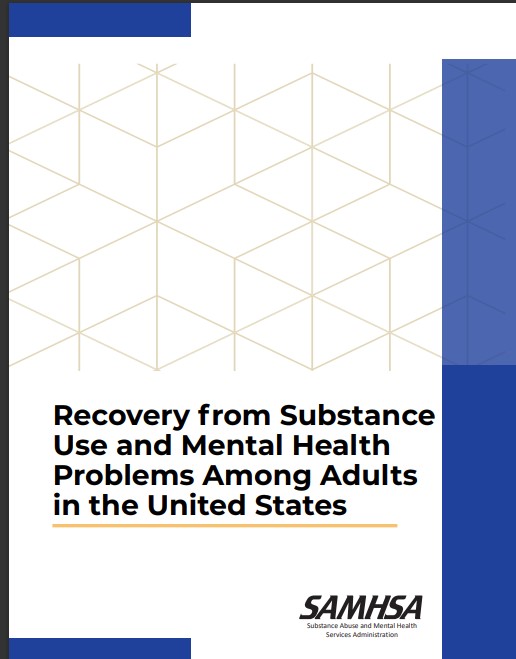Mental Health Problems Among Adults in the United States

Mental Health
Problems Among Adults
in the United States
Mental Health Problems Among Adults in the United States – This brief report presents self-reports of recovery among adults aged 18 and older in the United States who thought they ever had a problem with their use of drugs or alcohol and/or mental health.
Recovery for substance use or mental health problems differed by age, family income, education, marital status, and importance of religious beliefs.
Adults who participated in at least one government assistance program, had a lower level of education, or had a lower family income relative to the federal poverty level tended to have a higher prevalence of substance use recovery, but a lower prevalence of mental health recovery.
The percentage of adults in mental health recovery tended to be higher among those who were insured, had better overall health, were heterosexual, or were never arrested or booked for breaking the law.
Further, the percentage of adults in recovery tended to be lower among those with past-year serious psychological distress, substance use disorder (SUD), co-occurring mental illness and SUD, alcohol use, marijuana use, or cocaine use.
Substance use recovery was more prevalent among adults who received lifetime or past year substance use treatment.
Similarly, mental health recovery was more prevalent among adults who received past-year mental health treatment. These findings provide a clearer characterization of the factors associated with recovery among adults and how future efforts can foster a whole-health approach to sustain recovery from mental health and substance use conditions.
Substance use and mental health conditions impact individuals from all walks of life, and across all age groups. While these conditions are common, recurrent, and often serious, they are preventable and treatable; and many individuals do recover.
In 2022, the Substance Abuse and Mental Health Services Administration (SAMHSA) reaffirmed its definition of recovery as “a process of change through which individuals improve their health and wellness, live self-directed lives, and strive to reach their full potential” (SAMHSA, 2012).
The process of recovery is highly personal and occurs via many pathways. It may include clinical treatment, medications, faith-based approaches, peer support, family support, self-care, and other approaches.
A better understanding of those who self-identify as in recovery, particularly during the COVID-19 pandemic, is crucial if data-driven efforts are to foster recovery through expanded access to treatment and recovery services.
This report summarizes perceived recovery, hereafter referred to as “recovery,” among U.S. adults. The following sections present the prevalence of substance use and mental health recovery among adults who perceived that they ever had a problem with their substance use or mental health, stratified by population characteristics related to sociodemographic factors, substance use, SUD, mental health, and treatment.
III. METHODS
Data Source
The National Survey on Drug Use and Health (NSUDH) is an annual survey sponsored by SAMHSA, an agency within the U.S. Department of Health and Human Services. NSDUH’s data collection protocol was approved by the U.S. Office of Management and Budget and the institutional review board at Research Triangle Institute International. Informed consent was obtained from each NSDUH participant.
NSDUH collects information from residents of households and noninstitutional group quarters (e.g., shelters, rooming houses) and from civilians living on military bases.
The survey excludes unhoused people who do not use shelters, military personnel on active duty, and residents of institutional group quarters, such as jails and hospitals.
The 2021 NSDUH used multimode data collection, in which respondents completed the survey via the web or in person in eligible locations. The weighted household screening response rate was 22.2%, and the weighted interview response rate was 46.2% for 2021.
Additional details about the NSDUH methods are provided in the 2021 Methodological Summary and Definitions report (Center for Behavioral Health Statistics and Quality [CBHSQ], 2022).
A total of 69,850 respondents aged 12 or older completed the survey in person or via the web in 2021. This brief report utilized the 2021 NSDUH restricted-use file to examine data from adults aged 18 years and older who reported that they ever had a problem with their drug use, alcohol use, or mental health.
IV. MEASURES
Respondents aged 18 or older were asked whether they thought they ever had a problem with their use of drugs or alcohol or whether they thought they ever had a problem with their mental health.
Respondents who reported that they ever had a problem with their drug or alcohol use were asked whether they considered themselves (at the time they were interviewed) to be in recovery or to have recovered from their drug or alcohol use problem.
Similarly, respondents who reported that they had a problem with their mental health were asked whether they considered themselves (at the time they were interviewed) to be in recovery or to have recovered from their mental health problem.
Additional measures were created to demonstrate the presence of a perceived substance use and/or mental health problem and recovery from a substance use and/or mental health problem.
Additionally, NSDUH collected information on:’
• Sociodemographic characteristics: Sex, age, race and ethnicity, health insurance coverage, participation in a government assistance program, family income relative to the federal poverty level, marital status, sexual identity, veteran status, educational attainment, employment status.
• Other social determinants of health: Overall health, importance of religion, criminal justice system involvement.
• Perceived COVID-19 pandemic impact: Mental health, amount of alcohol or drug use.
• Substances used in the past year: Tobacco, alcohol, marijuana, cocaine, hallucinogens, prescription pain relievers, prescription tranquilizers, prescription sedatives, prescription stimulants.
• SUD in the past year, using diagnostic criteria from the Diagnostic and Statistical Manual of Mental Disorders (Fifth Edition).
• Treatment for illicit drug or alcohol use in the past year.
• Mental health in the past year: Serious thoughts of suicide, psychological distress, mental illness.
• Mental health treatment in the past year.
READ MORE INSIDE…
“MENTAL HEALTH PROBLEMS AMONG ADULTS IN THE UNITED STATES” $9.95
Our 100% Money Back Guarantee:

If for any reason you decided within 30 days that “Mental Health Problems Among Adults in the United States” isn’t for you, simply notify us by email and we’ll gladly refund your money – no questions asked. That’s our Ironclad Guarantee!
The risk is entirely ours! You absolutely have nothing to lose!
Warmest Regards, Coyalita
Behavioral Health Rehabilitative Specialist & Addiction Counselor
Copyright © 2021-2024 Thresholdlivecoyalita.com All Rights Reserved Privacy Policy – Earnings Disclaimer – Terms of Use – Contact Us





